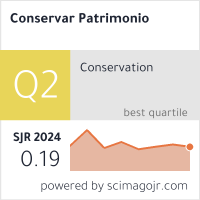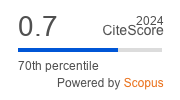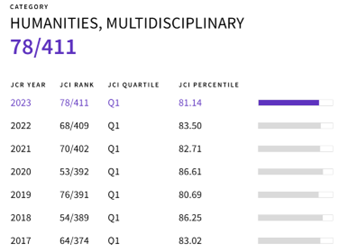Assessment of natural aging and ecological surface treatments in earth renders
DOI:
https://doi.org/10.14568/co2019005Keywords:
Mortar, In situ characterisation, Durability, Natural exposure, Clayish earth, CoatingAbstract
In conservation, earth renders can be used as sacrificial coatings. However, earth presents vulnerability when in contact with water. The application of ecological surface treatments on earth renders can be of great relevance, ensuring their durability while increasing eco-efficiency and extending its range of applications. The behaviour of a ready-mixed earth render applied in situ, on adobe and concrete block masonry experimental walls exposed outdoors with protection, and under controlled laboratory conditions, on hollow bricks, was evaluated after four years. Several superficial treatments were applied on the renders: linseed oil, mucilage of aloe vera and pasta and rice cooking water. The renders were characterized by non-destructive tests. The surface treatment with linseed oil presents good results and improves the durability of the earth render, giving it adequate protection against natural degradation.
Received: 2019-3-1
Revised: 2019-4-17
Accepted: 2019-10-20
Online: 2020-4-15
Publication: 2020-11-27
Downloads
References
[1] Bruno, P.; Faria,P.; Candeias, A.; Mirão, J., ‘Earth mortars from on pre-historic habitat settlements in south Portugal. Case studies’, Journal of Iberian Archaeology 13 (2010) 51-67. http://hdl.handle.net/10362/9954.
[2] Emiroğlu, M.; Yalama, A.; Erdoğdu, Y., ‘Performance of ready-mixed clay plasters produced with different clay/sand ratios’, Applied Clay Science 115 (2015) 221-229. https://doi.org/10.1016/j.clay.2015.08.005.
[3] Niroumand, H.; Kibert, C. J.; Barcelo, J. A.; Saaly, M., ‘Contribution of national guidelines in industry growth of earth architecture and earth buildings as a vernacular architecture’, Renewable and Sustainable Energy Reviews 74 (2017) 1108-1118. https://doi.org/10.1016/j.rser.2017.02.074.
[4] Cantù, M.; Giacometti, F.; Landi, A. G.; Riccardi, M. P.; Tarantino, S. C; Grimoldi, A., ‘Characterization of XVIIIth century earthen mortars from Cremona (Northen Italy): Insights on a manufacturing tradition’, Materials Characterization 103 (2015) 81-89. https://doi.org/10.1016/j.matchar.2015.03.018.
[5] Gomes, M. I.; Faria, P.; Gonçalves, T. D., ‘Earth-based mortars for repair and protection of rammed earth walls. Stabilization with mineral binders and fibers’, Journal of Cleaner Production 172 (2018) 2401-2414. https://doi.org/10.1016/j.jclepro.2017.11.170.
[6] Santos, T.; Faria, P.; Santos Silva, A., ‘Avaliação in situ do comportamento de rebocos exteriores de argamassas de terra com baixas adições de cais’, Conservar Património 26 (2017) 11-21. https://doi.org/10.14568/cp2016022.
[7] Morton, T., Earth masonry. Design and Construction Guideline, IHS BRE Press, Bracknell (2008).
[8] Minke, G., Building with Earth. Design and Technology of a Sustainable Architecture, WITpress, Berlin (2006).
[9] Mèlia, P.; Ruggieri, G.; Sabbadini, S.; Dotelli, G., ‘Environmental impacts of natural and conventional building materials: a case study on earth plasters’, Journal of Cleaner Production 80 (2014) 176-186. https://doi.org/10.1016/j.jclepro.2014.05.073.
[10] Cagnon, H.; Aubert, J. E.; Coutand, M.; Magniont, C., ‘Hygrothermal properties of earth bricks’, Energy and Buildings 80 (2014) 208-217. https://doi.org/10.1016/j.enbuild.2014.05.024.
[11] Lima. J.; Faria, P.; Santos Silva, A., ‘Earthen plasters based on illitic soils from Barrocal region of Algarve: contributions for building performance and sustainability’, Key Engineering Materials 678 (2016) 64-77. https://doi.org/10.4028/www.scientific.net/KEM.678.64.
[12] Ashour, T.; Georg, H.; Wu, W., ‘An experimental investigation on equilibrium moisture content of earth plaster with natural reinforcement fibres for straw bale buildings’, Applied Thermal Engineering 31 (2011) 293-303. https://doi.org/10.1016/j.applthermaleng.2010.09.009.
[13] Liuzzi, S.; Stefanizzi, P., ‘Experimental investigation on lightweight and lime stabilized earth composites’, Key Engineering Materials 666 (2016) 31-45. https://doi.org/10.4028/www.scientific.net/KEM.666.31.
[14] Randazzo, L.; Montana, G.; Hein, A.; Castiglia, A.; Rodonò, G.; Donato, D. I., ‘Moisture absorption, thermal conductivity and noise mitigation of clay based plasters: the influence of mineralogical and textural characteristics’, Applied Clay Science 132-133 (2016) 498-507. https://doi.org/10.1016/j.clay.2016.07.021.
[15] Bruno, A. W.; Gallipoli, D.; Perlot, C.; Mendes, J., ‘Effect of stabilisation on mechanical properties, moisture buffering and water durability of hypercompacted earth’, Construction and Building Materials 149 (2017) 733-740. https://doi.org/10.1016/j.conbuildmat.2017.05.182.
[16] Maskell, D.; Thomson, A.; Walker, P.; Lemke, M., ‘Determination of optimal plaster thickness for moisture buffering of indoor air’, Building and Environment 130 (2018) 143-150. https://doi.org/10.1016/j.buildenv.2017.11.045.
[17] Faria, P.; Lima, J., Rebocos de terra, Cadernos de Construção com Terra 3, Argumentum, Lisboa (2018).
[18] Faria, P.; Santos, T.; Aubert, J. E., ‘Experimental characterization of an earth eco-efficient plastering mortar’, Journal of Materials in Civil Engineering 28(1) (2016). https://doi.org/10.1061/(ASCE)MT.1943-5533.0001363.
[19] Santos, T.; Nunes, L.; Faria, P., ‘Production of eco-efficient earth-based plasters: Influence of composition on physical performance and bio-susceptibility’, Journal of Cleaner Production 167 (2017) 55-67. https://doi.org/10.1016/j.jclepro.2017.08.131.
[20] Delinière, R.; Aubert, J. E.; Rojat, F.; Gasc-Barbier, M., ‘Physical, mineralogical and mechanical characterization of ready-mixed clay plaster’, Building and Environment 80 (2014) 11-17. https://doi.org/10.1016/j.buildenv.2014.05.012.
[21] Santos, T.; Faria, P.; Silva, V., ‘Can an earth plaster be efficient when applied on different masonries?’, Journal of Building Engineering 23 (2019) 314-323. https://doi.org/10.1016/j.jobe.2019.02.011.
[22] Stazi, F.; Nacci, A.; Tittarelli, F.; Pasqualini, E.; Munafò, P., ‘An experimental study on earth plasters for earthen building protection: The effects of different admixtures and surface treatments’, Journal of Cultural Heritage 17 (2016) 27-41. https://doi.org/10.1016/j.culher.2015.07.009.
[23] Matero, F. ‘Mud brick metaphysics and the preservation of earthen ruins’, Conservation and Management of Archaeological Sites 17(3) (2015) 209-223. https://doi.org/10.1080/13505033.2015.1129798.
[24] Vissac, A.; Bourgès, A.; Gandreau, D.; Anger, R.; Fontaine, L., Argiles & biopolymers. Les stabilisants naturels pour la construction en terre, CRAterre, Villefontaine (2017).
[25] Lima, J.; Silva, S.; Faria, P., ‘Rebocos de terra: Influência da adição de óleo de linhaça e comparação com rebocos convencionais’, em TEST&E 2016 – Ensaiar para Reabilitar, Atas do 1º Congresso de Ensaios e Experimentação em Engenharia Civil, Lisboa, Portugal (2016). https://doi.org/10.5281/zenodo.164637.
[26] Kita, Y., ‘The functions of vegetable mucilage in lime and earth mortars – A review’, em HMC2013 - 3rd Historic Mortars Conference (CD), Glasgow, Escócia (2013).
[27] NP EN 1097-3 (2000) Ensaios para determinação das propriedades mecânicas e físicas dos agregados. Parte 3: Método para determinação da massa volúmica e dos vazios. IPQ: Caparica, Portugal.
[28] EN 1015-3 (1999) Methods of test for mortar for masonry. Part 3: Determination of consistence of fresh mortar (by flow table). CEN: Bruxelas, Bélgica.
[29] EN 1015-6 (2006) Methods of test for mortar for masonry. Part 6: Determination of bulk density of fresh mortar. CEN: Bruxelas, Bélgica.
[30] EN 1015-7 (1998) Methods of test for mortar for masonry. Part 7: Determination of air content of fresh mortar. CEN: Bruxelas, Bélgica.
[31] DIN 18947 (2013) Earth plasters. Terms and definitions, requirements, test methods. Deutsches Institut für Normung EV: Berlim, Alemanha.
[32] Drdácky, M.; Lesák, J.; Niedoba, K.; Valach, J., ‘Peeling tests for assessing the cohesion and consolidation characteristics of mortar and render surfaces’, Materials and Structures 48 (2014) 1947-1963. https://doi.org/10.1617/s11527-014-0285-8.
[33] ASTM D2240 (2000) Standard test method for rubber property – durometer hardness. ASTM Standards: Estados Unidos da América.
[34] ASTM C805 (2008) Standard test method for rebound hammer of hardened concrete. ASTM Standards: Estados Unidos da América.
[35] FE Pa 25 (1980) Ficha de ensaio para revestimentos de paredes – Ensaio de choque da esfera. LNEC: Lisboa, Portugal.
[36] FE Pa 43 (2010) Ficha de ensaio para revestimentos de paredes – Ensaio de avaliação de características mecânicas por ultra-sons. LNEC: Lisboa, Portugal.
[37] NP EN 12504-4 (2007) Ensaios de betão nas estruturas. Parte 4: Determinação da velocidade de propagação dos ultra-sons. IPQ: Caparica, Portugal.
[38] Malanho, S.; Veiga, R., ‘Análise do comportamento mecânico em laboratório e in situ de revestimentos pré-doseados de cimento’, em 3º Congresso Português de Argamassas de Construção, APFAC (CD), Lisboa, Portugal (2010).
[39] Veiga, M. R.; Velosa, A.; Magalhães, A., ‘Experimental applications of mortars with pozzolanic additions: Characterization and performance evaluation’, Construction and Building Materials 23 (2009) 318-327. https://doi.org/10.1016/j.conbuildmat.2007.12.003.
[40] Tavares, M.; Veiga, M. R.; Fragata, A., ‘Conservation of old renderings – the consolidation of rendering with loss of cohesion’, em HMC2008 – 1st Historical Mortars Conference (CD), Lisboa, Portugal (2008).
[41] Faria, P.; Silva, V.; Jamú, N.; Dias, I., ‘Evaluation of air lime and clayish earth mortars for earthen wall renders’, em Vernacular Heritage and Earthen Architecture: Contributions for Sustainable Development, ed. M. Correia, G. Carlos, S. Rocha, CRC Press/Taylor & Francis Group, Londres, Reino Unido (2014) 407-413.

Downloads
Published
How to Cite
License
This work is distributed under a Creative Commons Attribution License (CC BY-NC-ND 4.0) which permits use, distribution, and reproduction in any medium following no commercial or derivatives, provided the original author and source are credited.
Copyright remains with the authors.






